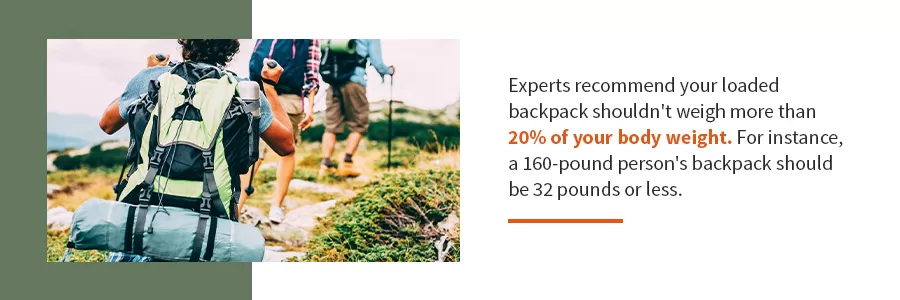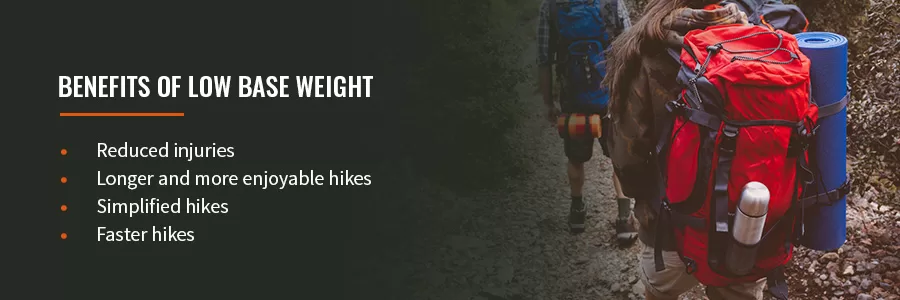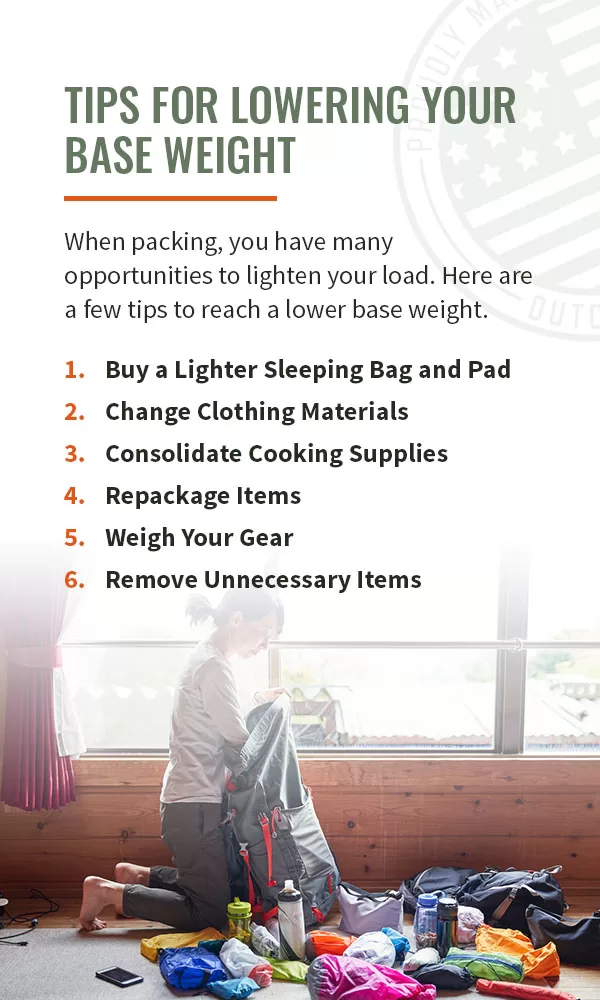March 31, 2023
posted in: Miscellaneous
What Is Base Weight and How to Lower it?

Backpacking is an immersive camping experience. You can explore the deep backcountry while carrying essential supplies in your backpack. These extended trips allow you to experience nature more intimately and create long-lasting memories of your exploration.
One essential aspect of backpacking is reaching an ideal base weight, which is your backpack’s total weight minus consumables like food and water. In other words, it’s the consistent load you carry during the trip. Lower base weights provide more comfort during extended hikes, allowing you to travel further with less strain on your body.
Read on to learn more about base weights and how to reach the best one for you.
Understanding Base Weight
Base weight consists of your backpack’s overall heaviness without consumables. Your consumables are items you use completely during the trip, resulting in zero weight. For instance, you begin with complete loads of food, water, and fuel. As your hike progresses, you use these items until the weight is gone. Consumables cause fluctuations in your backpack’s weight, so it’s often more beneficial to measure base weight instead.
Your base weight remains constant throughout your entire journey. It includes items like:
- Sleeping bag or top quilts
- Sleeping pad or under quilts
- Cooking utensils
- Tent or hammock
- Additional clothing
- First-aid kit
- Flashlight or headlight
- Extras like books or cameras
- Other camping gear
You can use scales to add up the total weight of all these items and calculate your backpack’s base weight. You should add the totals before placing consumables into your bag.
It’s also essential to understand the difference between base and pack weight. Pack weight measurements include consumables like food, water, and fuel. In other words, your total pack weight is the sum of everything in your bag. Your pack weight varies throughout the trip as you consume food, drink water, and burn fuel.
Most backpackers believe base weight is the more valuable measurement for trip planning. Your base weight stays consistent throughout your journey, while pack weight shifts after each meal. By anticipating your base weight, you understand what you carry during the whole trip. Then, you can prep for a heaviness level that suits your physical needs.

What Is an Ideal Base Weight?
The best base weight varies by person. It depends on your size, physical abilities, and preferences. If your load is too heavy, it strains your body and makes your trip less enjoyable. In severe cases, bulky loads can cause injuries.
Experts recommend your loaded backpack shouldn’t weigh more than 20% of your body weight. For instance, a 160-pound person’s backpack should be 32 pounds or less. Heavier weights place too much stress on your body and can cause discomfort. The additional weight also impacts smaller frames more than larger ones. You should add weight in proportion to your body size to keep things safe.
Once you calculate a base weight proportionate to your size, test it and ensure it is manageable. Finding a comfortable load is crucial for an enjoyable journey.
Traveling in a backpacking group can make establishing an ideal base weight easier. With multiple people cooperating, you can share loads more evenly and reduce base weights. For example, you can divide cooking supplies among each other. In addition, your group might range in backpacking experience and physical abilities. Experienced hikers might be willing to carry more and help newcomers start with lighter loads. Or, strong and athletic backpackers might pack more essentials to lighten the weight for their companions.
In addition, a good base weight depends on factors like these.
- Trip duration: Generally, longer trips require more clothing and supplies. Depending on your plans, your backpacking trip could range from one night to 6 months. You can expect a heavier base weight for extended journeys and might find it more challenging to reduce your overall weight.
- Personal preferences: When planning for a backpacking expedition, consider your comfort levels. Some hikers prefer increased base weights to have more supplies at camp. For instance, you could pack extra blankets, books and other entertainment forms, or a hammock for relaxation. While these extras raise your base weight, you might find it worthwhile. Ultralight backpackers prefer the lightest burden possible to make their movements more enjoyable. Consider your preferences and pack accordingly.
- Expected weather conditions: It’s crucial to research the weather before embarking on your trip. Freezing temperatures or snowy conditions require heavier clothing, which can increase your backpack’s weight. You might also consider insulated sleeping bags for frigid conditions. Sunny, hot weather might cause you to sweat more and need more changes of clothes. In addition, you could need sunscreen, sunglasses, or other protective tools.
Consider your body weight and these influencing factors while planning your base weight. As you take more trips, you can adjust the heaviness according to your hiking experiences.

Benefits of Low Base Weight
Ideally, you should keep your base weight as low as possible. While the best base weight varies by person, low base weights can lead to more successful and fulfilling trips.
These are other benefits of decreased base weights.
- Reduced injuries: A low base weight ensures you stay within a safe range. Many backpacking routes require hiking several miles daily, and you must carry your pack throughout all of them. Excessive loads strain your back, shoulders, waist, knees, and feet. Lowering your weight protects you from extra stress and reduces the risk of injury.
- Longer and more enjoyable hikes: The lighter your load, the easier it is to move. Instead of straining through the heaviness, your hikes become more enjoyable as you focus on heartfelt conversations or beautiful scenery. Longer journeys also become more manageable. If your weight becomes too heavy, you might have to stop trips early or plan for shorter durations. Low base weights create the ideal flexibility for your trips.
- Simplified hikes: Less equipment can also reduce hike complexity. You can leave elaborate cooking ensembles, extra tent materials, or extraneous tools behind. You keep your load at a bare minimum and decrease stress throughout your journey. Once you reach camp, it’s easier to sort through your backpack and find essentials like your tent and clothing. You can set up and tear down camp faster, allowing you more time to enjoy nature and your companions’ company.
- Faster hikes: Smaller weights also let you move more quickly. Staying on track and reaching daily milestones is vital. If you aren’t frugal, you could run out of supplies before you return. You can trek through miles more quickly and with fewer breaks with lighter loads. Instead of struggling to keep pace, you shed unnecessary burdens and move freely.

Tips for Lowering Your Base Weight
A low base weight can improve your backpacking experience. However, you shouldn’t leave behind essential items when decreasing your pack’s base weight. Components like first-aid kits, fire starters, and extra food are crucial for your safety while backpacking. Insufficient packing can cause discomfort or scarcity during your hike, making it challenging to find ways to decrease your base weight.
When packing, you have many opportunities to lighten your load. Here are a few tips to reach a lower base weight.
1. Buy a Lighter Sleeping Bag, Pad, or Quilt
A sleeping bag helps you sleep comfortably during camping and backpacking trips. Many backpackers also carry sleeping pads for an additional cushion at night. These items take a significant percentage of your backpack’s weight, but you can find different ways to keep your load low.
If you have a bulky sleeping bag or pad, try switching to a lightweight option. The more compact your materials are, the easier it becomes to fit them into your bag. Synthetic materials often weigh the least, making them ideal choices. Sleeping bags built for sub-zero temperatures are usually heavier. If you aren’t going to experience below-zero temperatures, consider choosing different sleeping options.
You can also find sleeping pads with lighter weights. Some hikers choose partial sleeping pads that only support the head and torso instead of their entire body.
Quilts are also a common alternative and can be used interchangeably for hammocks and ground dwellers.
These smaller options can eliminate crucial pounds or ounces from your backpack.
2. Change Clothing Materials
Your clothes also significantly affect your backpack weight. It’s vital to pack extra layers for safety, but too many clothes can make your backpack uncomfortably heavy. Luckily, the material type is usually more crucial than the number of clothes you have.
Heavier materials might provide additional warmth, but they also increase your load. Options like denim, canvas, and cotton add unnecessary weight to your bag. They can also be uncomfortable during hikes because they become saturated with sweat and take time to dry.
Instead, opt for wool and polyester blends. These materials are moisture-wicking and quick-drying, making them beneficial during prolonged exercise.
You can evaluate the typical clothes you pack for backpacking and determine which items add excess weight. If needed, you can purchase new clothing that is lighter and more comfortable for hiking.
In general, it’s best practice to have two sets of clothing, one for hiking and one for sleeping.
3. Consolidate Cooking Supplies
Filling meals are essential for backpacking, allowing you to stay energized and comfortable. Pots and pans are necessary for cooking safely over a fire, but bringing too many supplies can dramatically increase your base weight.
One way to keep equipment weights low is to meal prep for one-pot meals. For instance, you could plan for meals like:
- Oatmeal
- Macaroni and cheese
- Pancakes
- Granola
- Ramen noodles
- Rice and beans
- Pasta with pesto sauce
These recipes require only one pot to mix and cook ingredients, making them ideal for base weights. Only plan complicated meals if you feel confident you can handle the additional equipment load. While they might sound delicious and nutritious, the extra cooking work and increased load can add more discomfort to your trip overall.
Freeze-dried and dehydrated foods are another great option for nutritious foods that keep your base weight low.
Consider lighter stoves and fuel options such as a wood-burning stove or alcohol stoves and measure out your fuel for the trip.
4. Repackage Items
Rearranging your items can also help reduce your base weight. Bulky packages decrease the space in your bag and might increase the weight. Consider transferring items in oversized boxes into smaller packaging.
For instance, an entire tube of toothpaste or a whole box of pasta would take up precious room in your backpack. You could use toothpaste tablets or use reusable travel containers instead. You should repackage your food into lightweight plastic bags rather than using their original packaging.
You can also leave behind extraneous packaging for your tent, hammock or sleeping bag. Most of these items have sacks or protective coverings you can remove before placing them in your backpack. Tents often come with bags for poles, stakes, and the tent itself. You could pack those components directly instead of adding the extra coverings.
5. Weigh Your Gear
A strategic way to reduce base weight is to weigh each item in your backpack individually. That way, you can identify the heaviest pieces and find ways to reduce their weight. You can use a kitchen or luggage scale to weigh each piece before placing it into your bag. Measure everything from the camp stove to your toothbrush.
You can also use the weighing process to narrow down options. You might have multiple jackets, shirts, or other pieces and can’t decide which would be best to bring. You could measure each to see which has the lowest weight.
Record each weight and keep them in a spreadsheet for quick access. Then, add them all together for an exact base weight. You can return to the document for future trips and make packing easier.
Here’s our favorite tool for monitoring pack weight.
6. Remove Unnecessary Items
Another strategy for lowering base weight is to study your packed gear once you return from a backpacking trip. You can unpack your bag and evaluate which items were workhorses and which went mostly unused. Sort them into piles to visualize the divide more clearly.
Then, you can determine whether the unused items are necessary for your next trip. You might have unworn clothes, fuel or uneaten food that you could go without next time. Or, maybe an extra pillow isn’t necessary and you can use your jacket instead. Making cuts like these helps you reach a goal base weight.
Shop Online With DutchWare Gear Today
Maintaining a safe base weight is crucial for successful backpacking. At DutchWare Gear, we aim to help customers find the best outdoor gear. We produce innovative and durable camping equipment that suits a wide range of outdoor activities. All our pieces have a limited environmental impact, from using recycled materials to minimal packaging.
We’re the one-stop shop for your next backpacking adventure. Whether you need lightweight apparel, condensed cooking supplies, or anything in between, DutchWare Gear has high-quality equipment you can count on.
To get started with DutchWare Gear, shop online today.


